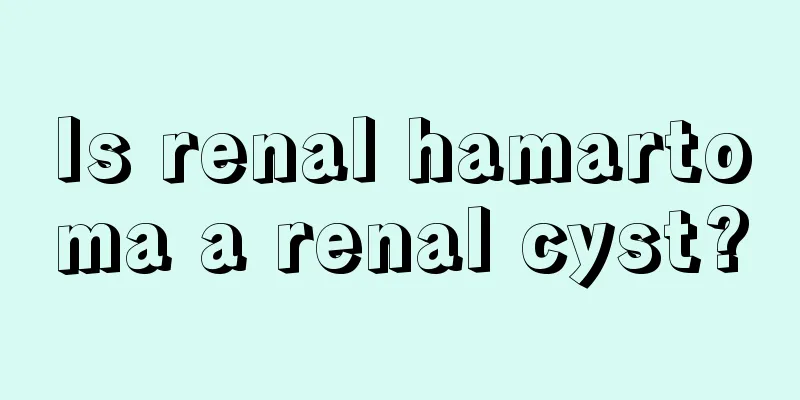Is renal hamartoma a renal cyst?

|
Renal hamartoma is not a renal cyst. Although both are kidney diseases, there are essential differences between them. They are two different diseases. Whether it is the pathogenesis, clinical manifestations or treatment principles, there are differences. They should not be confused. If patients cannot distinguish between the two diseases by themselves, it is recommended to seek medical treatment in time and let the doctor diagnose and judge. Although both renal hamartoma and renal cyst are kidney diseases, there are essential differences between the two. They are two different diseases, whether in pathogenesis, clinical manifestations or treatment principles. In life, people lack knowledge about these two diseases and often confuse the two, which is actually a misconception. So what are the differences between renal hamartoma and renal cyst? Specifically, they are manifested in the following aspects: 1. Different pathogenesis. Renal hamartoma is a benign tumor composed of abnormally proliferating blood vessels, smooth muscle and adipose tissue in different proportions. Therefore, it is also called renal angiomyolipoma. The cause is still unclear. Most renal cysts are simple renal cysts, and hereditary renal cysts account for a relatively small proportion. It is generally believed that simple renal cysts are caused by the increasing number of renal tubular diverticula with age. 2. Different clinical manifestations. The vast majority of patients with renal hamartomas do not have typical symptoms, but some renal hamartomas are relatively large and will compress organs such as the duodenum, causing digestive tract discomfort. Severe patients will have symptoms such as low back and abdominal pain, hematuria, and even shock. When a simple renal cyst is small in size, there are generally no obvious symptoms because there is no compression. Only when the cyst increases in size, compresses the blood vessels and urinary tract, and causes occlusion or obstruction will the corresponding manifestations appear, and may further affect renal function. 3. Different treatment principles. When the diameter of a renal hamartoma is less than 4 cm, no treatment is required, but close follow-up is required; when the diameter of a renal hamartoma exceeds 5 cm, hamartoma resection surgery is required. Since simple renal cysts have little impact on the body, they only require follow-up for 6 months to 1 year without treatment; but if the cyst diameter exceeds 5 cm, cyst fluid aspiration and intracystic injection of sclerosant, or surgical treatment is required. Although both renal hamartoma and renal cyst are benign tumors, they are essentially different in many aspects and are two completely different kidney diseases that should not be confused. If you cannot clearly distinguish between the two diseases in your life, it is recommended to seek medical attention in time, identify the symptoms, and seek treatment as soon as possible. |
Recommend
Reasons for the surge in colorectal cancer incidence
In recent years, the incidence of colorectal canc...
How can benign lymphoma be treated
Compared with malignant lymphoma patients, patien...
What to do if you have bad breath due to excessive stomach fire? What food can relieve it?
Because of the appearance of stomach fire, the bo...
Salmon reduces the risk of prostate cancer. What to eat for prostate cancer
Prostate cancer is a very common malignant tumor ...
Sequelae of sudden cerebral hemorrhage
Sudden cerebral hemorrhage is a disease that pose...
If you have neck discomfort, beware of cervical spondylosis
If your neck is uncomfortable, is it a stiff neck...
Who can't soak their feet in moxa leaves?
Soaking your feet in mugwort water can effectivel...
What medicine should I take for hematuria caused by chronic nephritis? It turns out that these three Chinese medicines have miraculous effects
Chronic nephritis is a relatively common disease ...
Is it useful to get a bivalent cervical cancer vaccine at the age of 40
It is still useful to vaccinate with a bivalent c...
Will nasopharyngeal carcinoma metastasize to lung cancer?
Can nasopharyngeal carcinoma metastasize to lung ...
How long after liposuction can I have sex?
Nowadays, many people need to lose weight, and th...
How to use hair clay to grab hair
Many young people want to have a cool hairstyle, ...
Seasonal peeling_How to treat seasonal hand peeling
The symptom of seasonal peeling will automaticall...
What are the nursing care for patients with cerebral hemorrhage?
Cerebral hemorrhage is a very common physical dis...
What are the chemotherapy drugs used in clinical treatment of lung cancer
Chemotherapy is one of the three main methods for...









